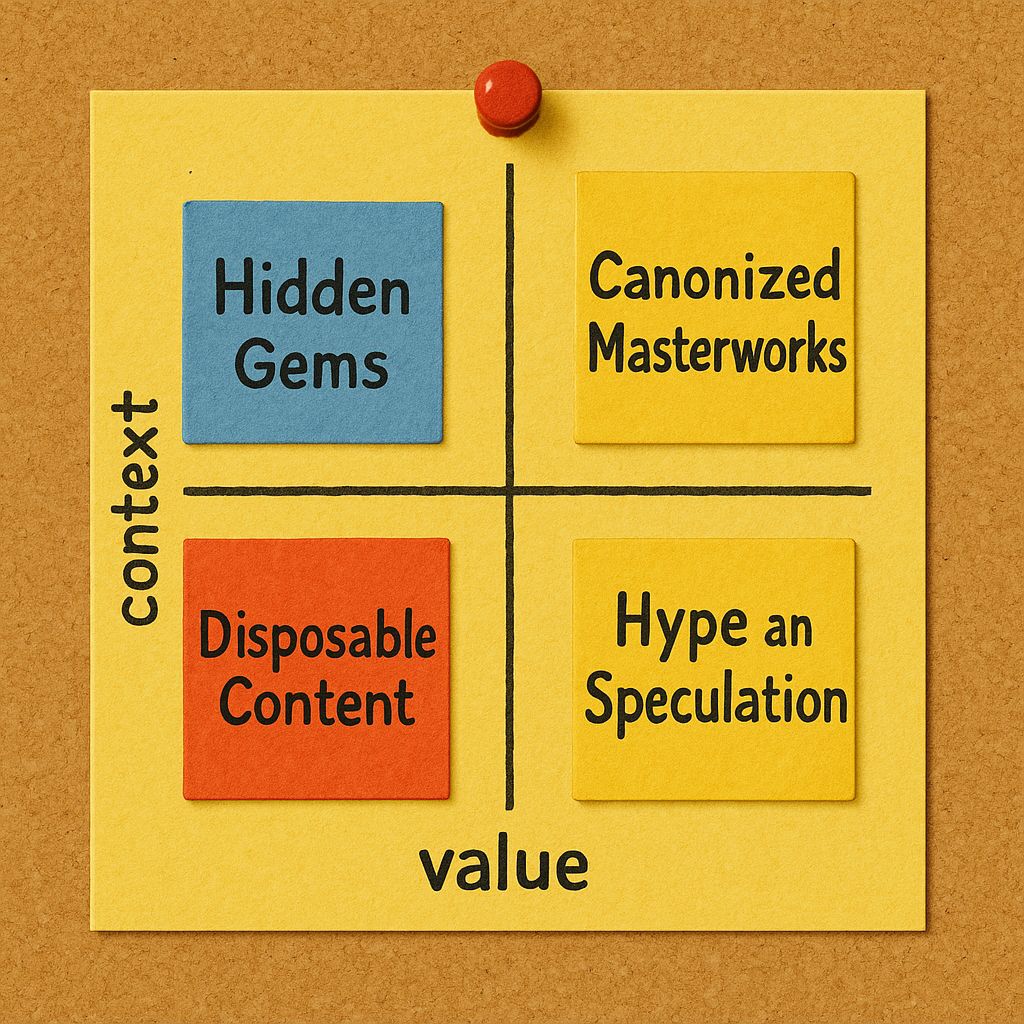- Verstreuen from GH
- Posts
- 🟨🟦🟥 Craft, Context & the Fragile Life of Art
🟨🟦🟥 Craft, Context & the Fragile Life of Art
Verstreuen from GH

Welcome to Verstreuen—meaning “to scatter”—where I unpack the ideas I’ve collected this week in my 🗃️ Zettelkasten, “note box,” personal knowledge management system. Here, I’ll share the highlights, insights, and stories I find interesting—and think you will too!
Forwarded this email? Subscribe here for more
🗃️ This Week’s Highlights
This week's notes come from 28 new additions to the Zettelkasten—here’s the three that stood out most to share with you:
🟨 The Value of Art: Mapping Meaning and Market
🟦 A Craftsman’s Kitchen: Lessons from Anthony Bourdain
🟥 When Commerce and Authenticity Collide
🟨🟨🟨
The Value of Art: A framework for classifying and valuing art that is not just practical but also rich in context.
What is the value of art?
It’s a question I’ve explored before, often contrasting art and science:
Science seeks “What is true.”
Art seeks “What is good.”
Both have their place - but lately, I’ve been thinking beyond purpose and toward value. Art’s worth isn’t just about price - it’s about meaning that compounds over time.
I recently came across a framework that maps art on two axes:
Perceived Value (X) → Market or collector hype
Contextual Value (Y) → Emotional, historical, and narrative richness

High Context + High Value → The Van Goghs: Market + meaning = enduring impact
High Context + Low Value → Hidden gems waiting for discovery
Low Context + High Value → Trendy NFTs or short-lived hype
Low Context + Low Value → Ephemeral noise
💡 Takeaway: In a world drowning in content, context is the multiplier. Meaning is what outlives speculation.
—🗃️—
🟦🟦🟦
“A good cook is a craftsman”
I’m just about finished with Kitchen Confidential by Anthony Bourdain.
It’s not the kind of “note-taking every five seconds” book I usually read, but it’s been a refreshing change of pace - perfect for listening on walks.
I started the chapter on staffing while leaving the library and took a seat on a bench outside to pause and listen in a little closer as Bourdain shared his values of what cooking, and specifically a good cook was.
“A good cook is a craftsman.”
He said it emphatically, rejecting the idea that a cook should be in any way an artist.
“an artist in the kitchen means trouble - someone more concerned with turning themselves on than pleasing the diner.”
At first, that felt odd. High-level cooking has always seemed more like edible art than a means of satiation. But as I sat on that park bench in the heat of the July sun, I started to understand his point.
Artists create for themselves.
Craftsmen create in service of others.
Bourdain’s distinction became even clearer later in the chapter
“The great cathedrals of Rome were built by craftsmen, but not designed by them.”
Visionaries provide the designs - but it’s the disciplined craftspeople who bring those visions to life.
Cooking, like so many meaningful pursuits, is a craft. It relies on:
Skill and repetition over inspiration.
Discipline over impulse.
Service to others over self-indulgence.
In the end, the craftsman leaves behind something that not only works - but endures. Lasting work is the product of craft, not fleeting artistic moods.
💡 Takeaway: Craft is the bridge between vision and endurance. What you make lasts because you’ve built it with discipline.
—🗃️—
🟥🟥🟥
Commerce heavily shapes creative success, making pure expression rare or unsustainable.
In today’s creator economy, a common claim circulates: “Authenticity is the new currency.” As new tools lower the barrier for creation, audiences increasingly crave work that feels raw, personal, and unfiltered.
But there’s a tension here - authentic art is finite.
Filmmaker Paul Schrader once shared his process for fiction writing like this:
Begin with a raw personal experience.
Translate it into a metaphor.
Build a narrative around it for others to enter.
Alfonso Cuarón’s life once felt unmoored, spinning out of control. That feeling became the seed for Gravity - a visceral spacewalk disaster film that transmits his sense of isolation and panic to the audience.
This is what makes authentic art powerful. But also rare.
You only have so many of those stories to give. Each one comes from a deep well of lived experience, and the well doesn’t refill on command.
And yet commerce demands the opposite: infinite stories, endless output, perpetual growth.
True art blooms slowly. It’s a rare flower that can’t be industrialized.
Commerce doesn’t always kill art - but it strains it. Authentic work burns bright and then, often, burns out.
The challenge for creators isn’t just making something real - it’s finding a sustainable rhythm where art can survive the weight of attention, expectation, and the market’s endless hunger.
💡 Takeaway: Authenticity is powerful but unsustainable at scale. Protect the well you draw from.
—🗃️—

Closing Thoughts
Across art, cooking, and creation:
Vision sparks. Craft carries.
Meaning compounds only when you give it context, structure, and care.
💬 Question for you:
Which part of your work is pure art - and which part is craft?
Thanks for reading Verstreuen! 👋
Until next week
-GH
